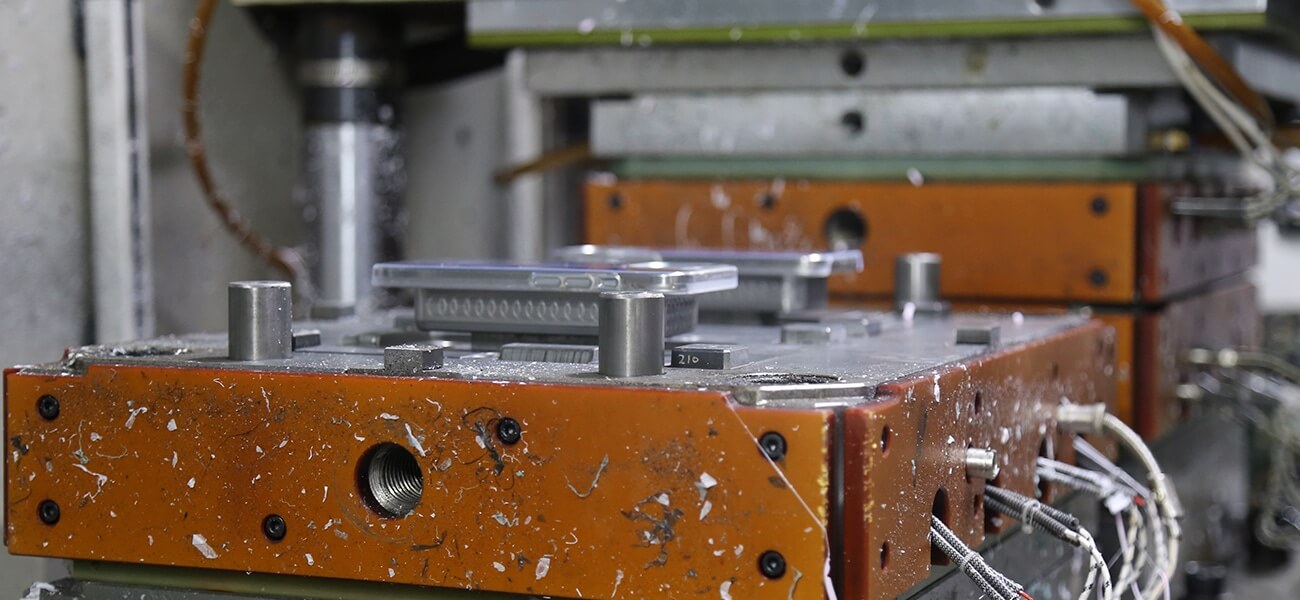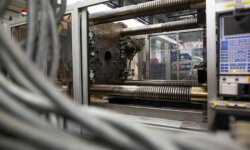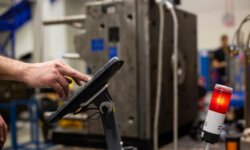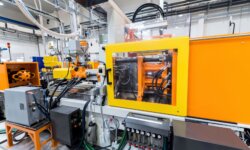The majority of parts made using injection molding are rigid plastic components. Typically, these parts are made from thermoplastics like ABS or PC, with different plastics offering different material properties to suit different applications.
However, injection molding can also be used to make flexible moldings: parts that are soft, pliable, shock-absorbing, ductile, or elastic. Products like hand grips, gaskets, protective smartphone covers, and certain medical implants all require a rubber-like material in order to perform their function, and injection molding offers two standout material options for making such products.
The first of these materials is liquid silicone rubber (LSR), a thermoset that requires its own special variant of the injection molding process. The other is a group of thermoplastics known as thermoplastic elastomers (TPEs), which can be processed like common rigid thermoplastics but which offer rubber-like properties.
This article examines the LSR vs TPE injection molding discussion, comparing material properties, advantages and disadvantages, and suitable applications.
What is liquid silicone rubber (LSR)?
Liquid silicone rubber is a high-purity form of cured silicone. It is a chemically inert thermoset with material characteristics such as biocompatibility, chemical resistance, water resistance, excellent compression set, flame retardancy, and heat resistance up to 250 °C.
Injection molding LSR requires a special process generally known as liquid silicone rubber molding. Unlike a standard injection molding machine, the equipment comprises a metered pumping device for dispensing the two liquid materials (catalyst and base forming silicone) and a mixer for combining the materials before they enter the mold. The mold cavity is heated, allowing vulcanization of the silicone to take place within the cavity.
What are thermoplastic elastomers (TPEs)?
Thermoplastic elastomers or thermoplastic rubbers are a class of thermoplastics exhibiting both thermoplastic and elastomeric material properties. Because they are thermoplastics, they are easier to manufacture than other rubber-like materials, being highly suited to injection molding and extrusion-style 3D printing.
TPEs have good thermal properties, good stability, and require minimal energy to manufacture. They can also be easily recycled, as TPE parts can be melted down without burning.
Some of the most common types of TPEs are:
- Thermoplastic polyurethanes (TPU): good clarity, good wear resistance, range of hardnesses
- Thermoplastics vulcanizates (TPV): matte finish, high compression set
- Styrenic block copolymers (TPS): highest level of flexibility among TPEs
- Polyolefin blends (TPO): tough, good impact strength
- Thermoplastic copolyesters (TPC): good tear strength, impact strength
- Thermoplastic polyamides (TPA): high temperature resistance, low compression set
LSR injection molding vs TPE injection molding
Both liquid silicone rubber and thermoplastic elastomers have their own unique advantages as injection molding materials. In short, LSR offers superior elastomeric performance in addition to chemical advantages, while TPE is easier and more convenient to process.
LSR advantages | TPE advantages |
Very high temperature resistance | Compatible with standard injection molding machine |
Biocompatibility for medical and food applications | Re-moldable and recyclable |
High level of tear strength | Fast, simple, and less expensive molding process |
Superior chemical resistance | Easy to add color with pigments |
Minimal warping even with uneven wall thicknesses | Heat sealable |
Superior compression set | Pellets easy to handle |
LSR injection molding applications
Although the liquid silicone molding process requires specialist equipment and requires longer molding cycles than thermoplastic injection molding, the unique benefits of LSR — such as its exceptional compression set — give it a number of important applications, from healthcare to industry.
Some injection molded silicone part examples include:
- Silicone medical implants such as orthopedics, cardiovascular stents, pacemakers, lenses, and soft tissue implants
- Medical devices such as surgical instruments and drug delivery devices
- Headphone and hearing aid tips
- Baby bottle tips
- Shower heads
- Electronic device components such as keyboard interfaces
- Electronic device protective covers and skins
- Watertight gaskets
- Heat-resistant and UV-resistant automotive components such as O-rings, bellows, and stoppers
TPE injection molding applications
Injection molding thermoplastic elastomers requires the same equipment and process as standard thermoplastics, making fabrication of TPE moldings fast, affordable, and simple. The material also offers important material properties, which can vary greatly depending on the type of TPE chosen.
Some injection molded thermoplastic elastomer part examples include:
- Soft-touch grips for handheld tools and devices (sometimes via overmolding)
- Certain food products such as bottle cap liners
- Electronic device components such as enclosures
- Electronic device protective covers and skins
- Shoe soles
- SCUBA flippers
- Wheels for skates and skateboards
- Sealing rings
- Automotive components such as suspension bushings
Design considerations
Although both LSR and TPEs can be injection molded, different design rules apply to the two materials.
Overall, LSR offers greater design freedom than thermoplastics like TPEs, mostly due to its extreme flexibility. Because silicone moldings are highly pliable, part ejection is simple: the soft part can usually be removed manually from the cavity without the use of ejector pins. Protruding undercuts are generally no problem either, as these sections can be squashed or bent around the corner of the mold.
Furthermore, because liquid silicone flows easily, product designers can be more liberal with uneven wall thicknesses — features that would potentially cause filling or warping issues with thermoplastics like TPEs. However, one advantage of TPEs over silicone is that the higher viscosity of the thermoplastic makes it less likely to leak out at the parting line and cause flash. Silicone molds require effective sealing and clamping to prevent flash.
3ERP offers a range of injection molding services, including plastic injection molding, silicone injection molding, and metal injection molding. Request a free quote for your next batch of flexible molded parts.








